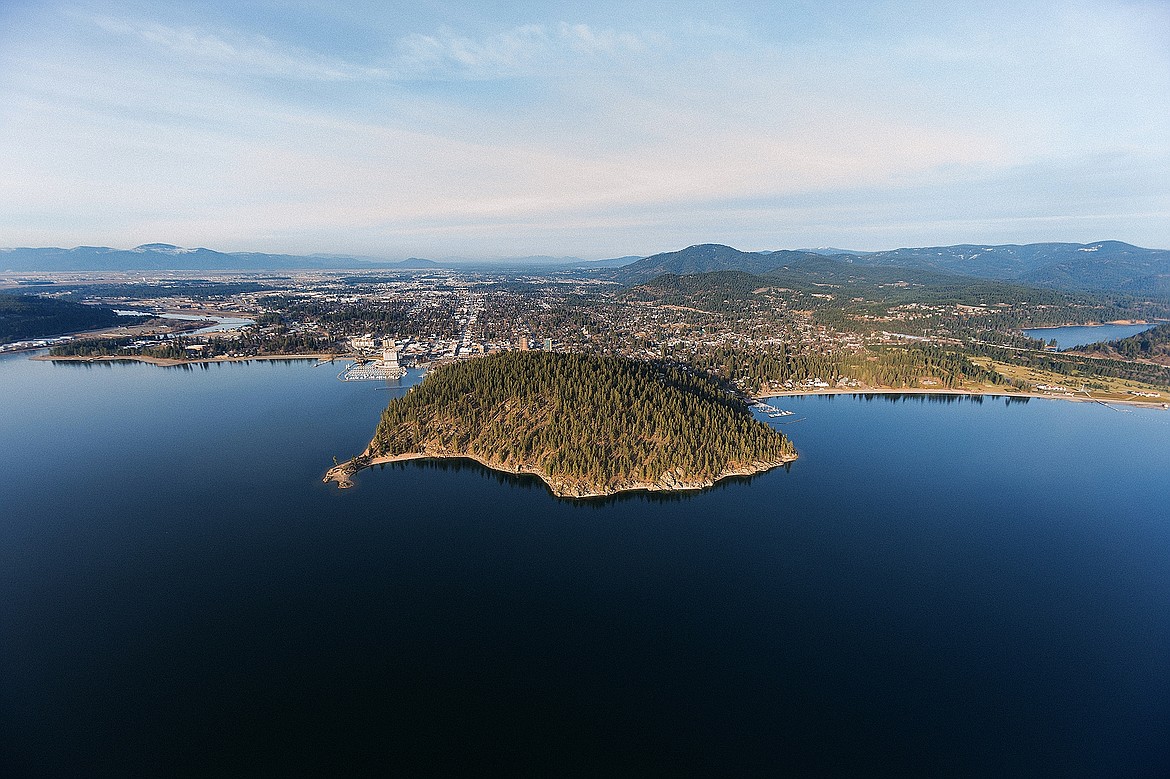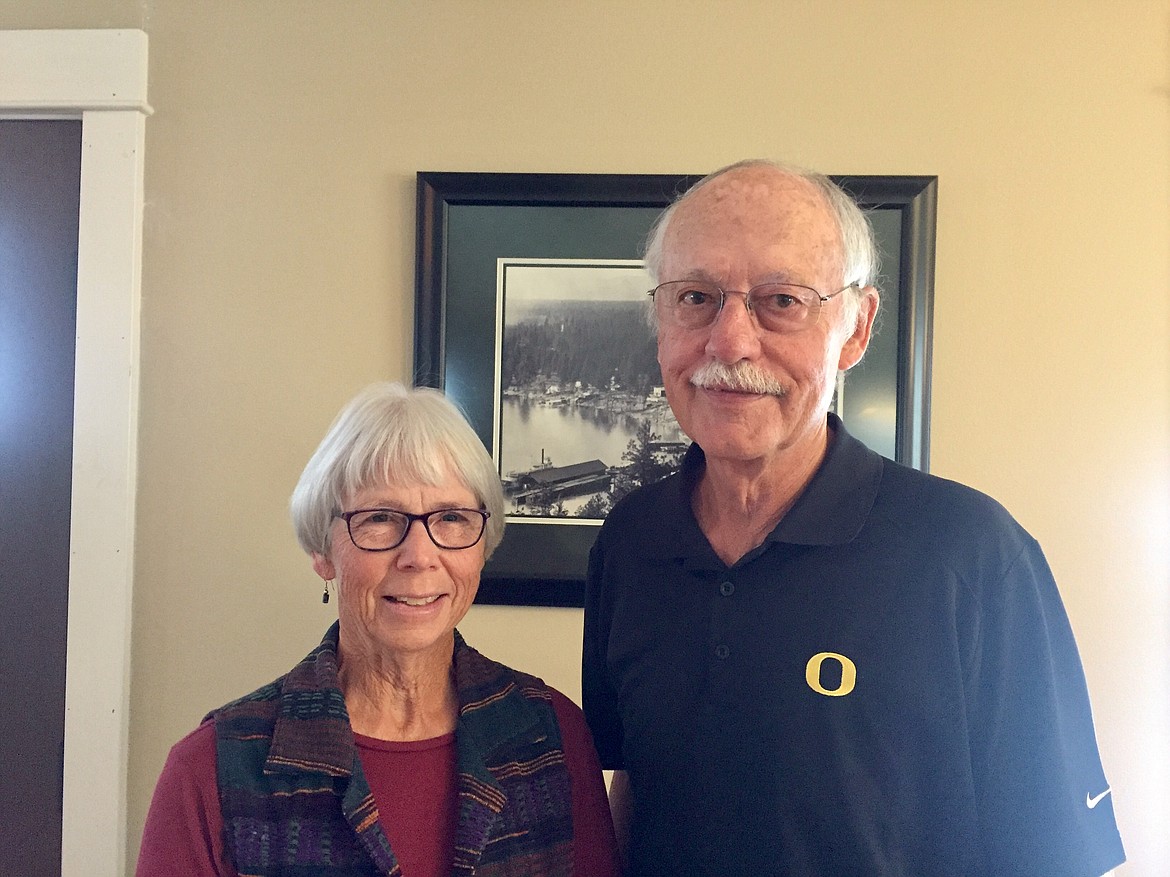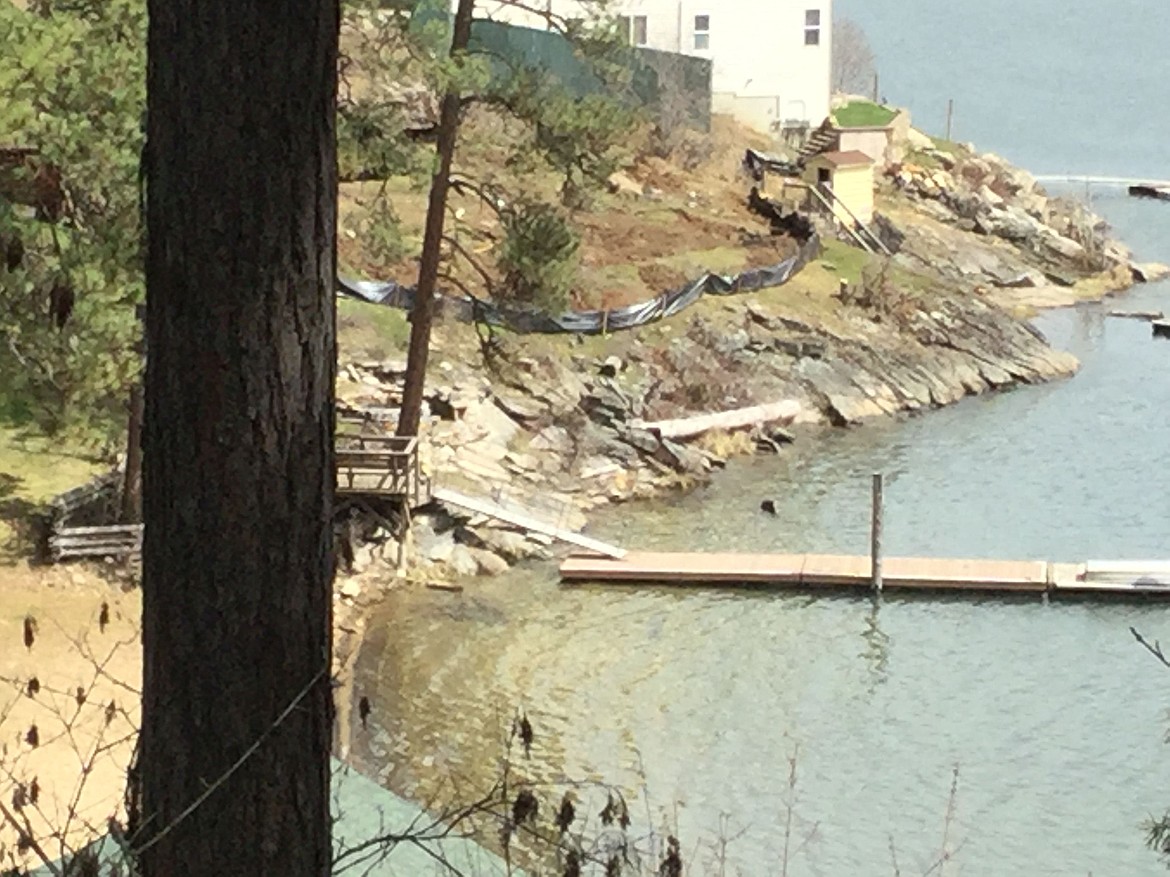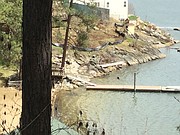The Great Lake Debate
JENNIFER PASSARO | Hagadone News Network | UPDATED 5 years, 9 months AGO
Shoreline concerns among threats to Lake Cd’A
In a packed room at the Iron Horse Restaurant in downtown Coeur d’Alene shortly before the coronavirus hit, the Four County Natural Resources Committee met over lunch.
Federal and state resource managers, scientists, concerned citizens, and a handful of local elected officials including Kootenai County Commissioner Chris Fillios and Coeur d’Alene City Council member Kiki Miller gathered to listen to a presentation about the health of Lake Coeur d’Alene.
The two limnologists charged with monitoring the lake’s health, Dale Chess of the Coeur d’Alene Tribe and Craig Cooper of Idaho Department of Environmental Quality, presented evidence that oxygen levels in the lake are going in the wrong direction. Phosphorus and nitrogen levels in the lake are increasing, depleting oxygen levels at a greater rate, they said. Cooper said that without any doubt, the phosphorus levels in the lake are continuing to rise.
At a kitchen table in a well-tended home in the Garden District, Lynn and Joe Morris explained how they became aware of the condition of the lake in the mid-’90s. The couple have owned lakeshore property in Kootenai County near Harrison for 31 years. They are thoughtful, well-spoken, and have deep concerns about the health of the lake and the community that depends on it.
Joe Morris served as the chief executive officer of Kootenai Health for 30 years, retiring in 2010. The couple now participates in a University of Idaho extension program called Bay Watchers, where citizens in the community monitor clarity, temperature, and oxygen levels in the lake.
“People are good at responding to sudden, visible threats,” Joe Morris said. “But the deterioration of the lake is a slow, invisible process. By the time it is visible and apparent to everyone, it may be too late. It is difficult to motivate people when they can’t see it or feel threatened.”
In 1983, the Environmental Protection Agency listed the Bunker Hill Mining and Metallurgical Complex, including Lake Coeur d’Alene, on the National Priorities List under Comprehensive Environmental Response, Compensation, and Liability Act (CERCLA), more commonly known as a Superfund site. It is currently the second largest in the country, outmassed only by Butte, Mont. At the time of federal designation, community leaders and business people advocated to leave the label off the lake.
“People didn’t want the lake to be a Superfund site,” Joe Morris said. “They didn’t like the sound of that.”
The EPA bowed to local interests, delegating lake management, cleanup, and funding responsibilities to the state, via the IDEQ and the Coeur d’Alene Tribe, whose reservation encompasses the lower third of the lake. The EPA focused its work and directed all funds for the Superfund site upriver.
The EPA funded a mediator to assist the state of Idaho and the Coeur d’Alene Tribe’s creation of the 2009 Lake Management Plan (LMP), which was non-regulatory in nature.
Through the LMP, scientists conduct monitoring studies and nutrient inventories, audit land management activities in the basin, and develop and operate predictive modeling scenarios. The LMP developed water quality thresholds to alert scientists when sites in the lake were in trouble.
The LMP’s efficacy relied heavily on land use management from separate regulatory authorities outside the jurisdiction of the tribe and IDEQ. Kootenai County’s elected officials and Idaho Department of Lands hold primary responsibility for land use practices that directly influence phosphate and nitrate levels in the lake. Ultimately, the power to regulate land use rests with Kootenai County’s community development department and the three elected commissioners, Chris Fillios, Bill Brooks and Leslie Duncan.
County regulations and ordinances for shoreline development include a 25-foot shoreline protection buffer, measured from the ordinary high water mark landward in a slope distance. The ordinance prohibits removal of native vegetation, site disturbance, or building a structure other than stairs or docks. The ordinance has not been modified since 1973, when the population of the entire county hovered around 40,000 and few people invested in the necessary architecture to build near the shoreline.
The county depends on citizen violation reports to investigate noncompliance with county ordinances.
“Our experience with the county is that for years when we report violations on the 25-foot buffer, site disturbances and the construction of roads on or near the shoreline to the county, there seems no will to enforce regulations,” Joe Morris said.
At a 4C’s meeting in early February, Kootenai County Community Development Director David Callahan said the county’s philosophy in how it addresses infractions and code violations needs to change. City violations go to municipal court, while county violations rarely go to district court.
Instead, when a code violation is filed with the county, a code officer usually does a “windshield survey” to see if the complaint has any validity. The officer does not go on private property to investigate the complaint. If a violation is identified, they contact the property owner to create a solution to the violation.
“Our staff make every effort to mitigate violations in an amicable way,” said Mary Shaw, Kootenai County Community Development Planning manager.
If the property owner is not willing to mitigate the infraction, then a notice of violation on property is mailed to the owner. The property owner has 45 days to file a resolution or a notice will be attached to the property title.
Phil Cernera, director of the Coeur d’Alene Tribe’s Lake Management Department, wants to know why the county relies on residents to report their neighbor’s violations. He urged the county to shift that responsibility to its own code enforcement officers.
“We need another county attorney that just does infractions,” Callahan said.
As growth clambers not just around the lake’s 133 miles of shoreline but throughout the 37,000 square miles that drain into it, an ideological war is gathering speed between property owners who feel their rights supersede the greater community’s rights to clean water.
“Twenty-five feet won’t cut it,” Callahan said, describing the slim riparian ribbon currently protected by county code.
Throughout Washington state, most shoreline requires a 200-foot setback. Bonner County requires a 60-foot setback for development along Lake Pend Oreille.
“We have witnessed an increase in not only illegal development, but building within the regulations that is detrimental to the health of the lake,” Joe Morris said.
The Morrises have reported neighbors fertilizing shoreline lawns and putting hydroseed on their beaches.
Senske Services, a lawn care business in Coeur d’Alene, has just a handful of customers with property adjacent to the lake.
“We will treat within 25 feet of the water,” said Becca Presley, director of Marketing and Communications. The company does not use its slow-release fertilizer on shoreline properties and while it is phosphate-free, it is nitrogen based.
Jim Ekins, area water educator for University of Idaho extension campus in Coeur d’Alene, provides community landscaping classes to give shoreline property owners ideas for how to protect the lake.
“Behavior change doesn’t just happen because there is science out there, but if people understand the science,” Ekins said.
Ekins encourages people to leave established native vegetation in place and to mitigate erosion by planting a diverse range of plants that will establish deep roots. These include red osier dogwood, hawthorne, maples, mock orange, and syringa. A native riparian buffer acts like a filter for water rushing toward the lake from roads and roofs.
Kootenai County Commissioner Bill Brooks didn’t want to talk about the health of the lake. When pressed, he shifted to the issue of shoreline erosion on the Spokane River from excessive wake.
When pressed again, Brooks said the county should enforce the shoreline ordinances that it has, but he doesn’t support adjusting the budget to do that.
The county currently has minimal staff tasked with investigating and enforcing code violations. In 2019, 68 shoreline violations were reported to the county. Forty-nine were inspected and determined to have no violations. Thirteen were closed due to corrective measures on the part of the property owners. Six cases are still open.
Lynn Morris explained how the couple built a house on the east side of the lake 75 feet back from the water, leaving all the natural vegetation in that 75 feet. The Morrises created a community sewer association with their neighbors, developing a drain field across the highway, far from the lake.
Kootenai County Commissioner Leslie Duncan said it’d be nice if the county could get all the homes along the lake on the sewer system, but she doesn’t think that will happen.
Duncan also worries that if the county were to take action and force the shoreline buffer back to 60 feet, it might not be enough to bring phosphate levels down. She declined to comment on whether she would advocate for extending the shoreline buffer at all.
In 2015, the county considered relaxing shoreline regulations. Led by then-commissioner Marc Eberlein, the county felt the regulations put too many restrictions on private property owners and trusted the public to do what was best.
Current commissioner Chairman Chris Fillios has a very different understanding of county involvement in lake management practices.
“I’m going to make a statement that I’ve made before: Our community will live or die by the health of Lake Coeur d’Alene,” Fillios said.
In 2019, the Coeur d’Alene Tribe withdrew from the LMP in large part because the elected officials of Kootenai County over the course of the plan’s lifetime consistently ignored and undermined the county’s shoreline regulations, Cernera said. The tribe no longer felt the LMP could be the non-Superfund remedy to protect the lake from one of the largest hazardous substance repositories in the world.
Gov. Brad Little has proposed a third-party review of all available data. Brooks said he’s eager to see that data, but declined to engage about the current data provided by IDEQ and the tribe. The National Academy of Science (NAS) will likely conduct that review over the course of two to three years, according to Cernera.
The LMP’s essential goal was to keep the lid on the toxic metals in the lake. By pulling out of the plan the tribe essentially sought federal intervention in the EPA’s five-year review, due in May. Over the last 10 years, county officials have repeatedly refused to acknowledge data presented by the state and the tribe in their land management practices.
The EPA’s decision to turn away from involvement in the lake was contingent upon the tribe and IDEQ’s participation in the LMP.
Jamie Brunner, Lake Management Plan supervisor for IDEQ, paused to consider her role in protecting the lake.
“I would really like, personally, for the local community to give the EPA feedback on what they’d like to see happen in the five-year review,” Brunner said. “It’s not my job to tell everybody else what should happen. It’s my job to represent the people who pay the taxes; what do they want?”
In February, county commissioners approved a preliminary subdivision application near Gozzer Ranch on the east side of Lake Coeur d’Alene. The 25-lot site sits on soil susceptible to rapid runoff and high erosion. A wetland between the lake and the approved development is also owned by the developer, Echo Bay Holdings. No mention of erosion or wetland impact was made by any county official during the proceedings.
“The county has the most jurisdiction on the lake,” Joe Morris said. “It seems to not have the will to do what’s necessary to protect the lake.”
Terry Harwood is the executive director of the Basin Environmental Improvement Project Commission. Harwood coordinates cleanup and environmental restoration throughout the Coeur d’Alene Basin. He’s worked as an environmental engineer for the government for 54 years from Guam to Alaska. But he grew up swimming, fishing, and drinking the cool, clean water from Lake Fernan on the eastern edge of Coeur d’Alene.
“Once you screw up a natural resource it’s darn near impossible to bring it back,” Harwood said. “It’s the local folks that have to make those decisions of what can and cannot be done.”
CLEANUP FEEDBACK
EPA has extended the public input period for its fifth Five-Year Review of the Bunker Hill Superfund Site cleanup, also known as the Coeur d’Alene Basin Cleanup. The public may share information and ideas by April 30, 2020.
Email input to Tamera Langton at [email protected] or call 206-553-2709 or 800-424-4372 ext. 2709.
Join the conversation on the CDA Basin Cleanup Facebook Page: www.facebook.com/cdabasin
More information can be found on the project web page: www.epa.gov/superfund/bunker-hill
ARTICLES BY JENNIFER PASSARO

In Reed’s words
Former legislator and co-founder of KEA releases book of columns

WINDOW to two WORLDS
Neighbors Spokane, Cd’A so close, yet so far away with COVID-19

‘Dysfunction junction’
Go online and help shape future of traffic project





